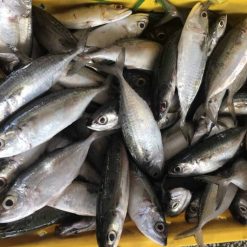Anchovy / Stolephorus commersonii
Vietnamese Name: Cá Cơm
Product details:
Anchovy / Stolephorus commersonii
Size : 3/5 cm, 4/6 cm, 5/7 cm
Description
An anchovy is a small, common forage fish of the family Engraulidae. Most species are found in marine waters, but several will enter brackish water and some in South America are restricted to fresh water.
The more than 140 species are placed in 17 genera; they are found in the Atlantic, Indian and Pacific Oceans, and in the Black Sea and the Mediterranean Sea. Anchovies are usually classified as oily fish.
Characteristics
European anchovy, Engraulis encrasicolus
Anchovies are small, green fish with blue reflections due to a silver-colored longitudinal stripe that runs from the base of the caudal (tail) fin. They range from 2 to 40 cm (0.79 to 15.75 in) in adult length, and their body shapes are variable with more slender fish in northern populations.
The snout is blunt with tiny, sharp teeth in both jaws. The snout contains a unique rostral organ, believed to be sensory in nature, although its exact function is unknown. The mouth is larger than that of herrings and silversides, two fish which anchovies closely resemble in other respects. The anchovy eats plankton and recently hatched fish.
Distribution
Anchovies are found in scattered areas throughout the world’s oceans, but are concentrated in temperate waters, and are rare or absent in very cold or very warm seas. They are generally very accepting of a wide range of temperatures and salinity. Large schools can be found in shallow, brackish areas with muddy bottoms, as in estuaries and bays. The European anchovy is abundant in the Mediterranean, particularly in the Alboran Sea, Aegean Sea and the Black Sea.
This species is regularly caught along the coasts of Crete, Greece, Sicily, Italy, France, Turkey,Northern Iran,Portugal and Spain. They are also found on the coast of northern Africa. The range of the species also extends along the Atlantic coast of Europe to the south of Norway. Spawning occurs between October and March, but not in water colder than 12 °C (54 °F). The anchovy appears to spawn at least 100 km (62 mi) from the shore, near the surface of the water.
Ecology
The anchovy is a significant food source for almost every predatory fish in its environment, including the California halibut, rock fish, yellowtail, shark, chinook, and coho salmon. It is also extremely important to marine mammals and birds; for example, breeding success of California brown pelicans and elegant terns is strongly connected to anchovy abundance.
Feeding behavior
Anchovies, like most clupeoids (herrings, sardines and anchovies), are filter-feeders that open their mouths as they swim. As water passes through the mouth and out the gills, food particles are sieved by gill rakers and transferred into the esophagus.
CONTACT US: THAI LIEN MANUFACTURING & TRADING COMPANY
Address: 336/9/4 Nguyen Van Luong, Ward 12, D.6, HCMC, Vietnam
Mobile/Wechat/Whatsapp: +84.908.794.118
Email: thaiphuong@tlcthailien.com – fionathai.thailientlc@gmail.com
Fanpage: Thai Lien Viet Nam























Reviews
There are no reviews yet.